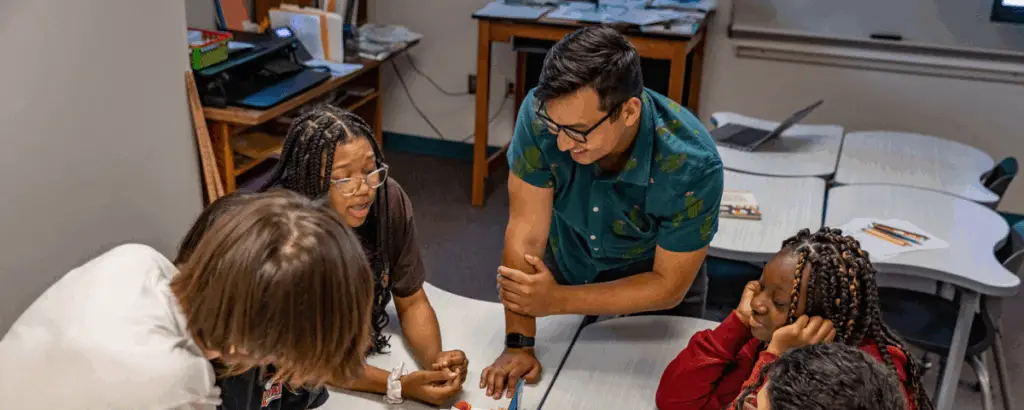Introduction
For over a century, the “egg-crate model of schooling,” which isolates each teacher in an individual classroom, has shaped the teaching profession. Some researchers have argued that certain accountability policies have reinforced the egg-crate model, especially during the height of value-added personnel decisions a decade ago, solidifying the structure’s “walls” and isolating teachers. But as pressures on educators increase, so, too, does the risk that the eggs in the crate might crack. For decades, a growing number of education researchers and organizations (e.g., Dan Lortie, Darrell West, Joshua Bleiberg, Arthur Wise) have questioned if it is time to dismantle the egg-crate model of school teaching and learning in favor of more collaborative, innovative approaches.
Such concerns are prompted by the fact that teacher satisfaction rates are low—and getting lower. While the 2024 Merrimack College Teacher Survey shows a modest decline in the percentage of teachers who report being “very satisfied” (from 20% to 18%), the persistently low satisfaction rate underscores the depth of the issue. This continuing drop in satisfaction may reflect how the egg-crate model of schooling has limited professional fulfillment and reduced opportunities for the collaboration, shared responsibilities, and mutual support that teachers desire. A new organizational framework, such as team-based staffing, may offer a potential solution to the challenges posed by the traditional one-teacher, one-classroom model of staffing schools, meeting both teacher and student needs through a more interconnected approach.
In fact, teachers themselves are saying precisely this. A 2024 survey by Educators for Excellence found that 81% of teachers are open to or in favor of restructuring schools to enable co- or team-teaching. Notably, teachers of color expressed even greater interest: 93% of teachers of color were open to or in favor of teaching in a co- or team-teaching model. With teacher retention and recruitment posing more of a problem than ever, it could be time to try a new, more collaborative approach.
When teachers are not empowered to make instructional or schoolwide decisions, they are at higher risk of leaving the profession. Innovative staffing models like the Next Education Workforce™ (NEW) respond directly to these challenges. NEW organizes educators into collaborative teams that share a larger roster of students, shift instructional responsibilities, and enable teachers to distribute their expertise. By fostering environments where teachers have greater autonomy and opportunities to work in teams, the NEW model aims to increase professional satisfaction, as well as retention rates, by giving teachers a stronger sense of agency and influence in their roles.
The NEW model is particularly relevant in Arizona, where the teaching profession is in crisis. According to the annual Arizona School Personnel Administrators survey, over 6,900 teacher positions were either filled by individuals not meeting standard certification requirements or vacant a few months into the 2024-2025 school year. This critical shortage underscores the urgent need for innovative models like NEW, which seeks to attract, retain, and sustain educators by rethinking the structure of schools and the teaching profession itself.
This study examines the relationship between the NEW model and teacher retention and decision-making influence, focusing on teachers in NEW models in Mesa Public Schools. Our analysis is guided by three key research questions:
- Implementation of the NEW Model: To what extent do teachers on NEW teams implement and practice the key elements of the NEW model?
- Teacher Decision-Making Influence: How does decision-making influence differ between NEW team members and non-NEW teachers, both within their classrooms and schoolwide?
- Relationship with Teacher Turnover: Are NEW team members less likely to depart their school or district, and does the level of decision-making influence relate to this relationship?
Key Findings
- High Implementation of NEW Model Practices: Between 80% and 93% of teachers that have selected into the NEW model reported actively practicing key elements of NEW, including collaborative planning, shared student rosters, and flexible scheduling, suggesting strong adherence to the model’s collaborative framework.
- Increased Decision-Making Influence: Compared to their non-NEW peers, 81% of NEW team members agreed they had autonomy in classroom instruction, while only 68% of non-NEW teachers reported the same. Within the NEW group, teachers reported significantly more influence over classroom decisions (81%) than over schoolwide policies (57%).
- Next Education Workforce Teacher Experience Lower Teacher Turnover: NEW team members had an 18.3% turnover rate compared to 22.6% for non-NEW teachers. While this raw difference was only borderline statistically significant, logistic regression models controlling for teacher and school characteristics showed that NEW team members were significantly less likely to leave. Predicted turnover estimates generated from our regression models revealed that the relationship between team membership and retention becomes especially pronounced when combined with high levels of decision-making influence. For instance, teachers who were both NEW team members and reported strong decision-making influence had a modeled annual turnover rate as low as 3%. These predicted probabilities represent average marginal effects after controlling for teacher and school characteristics.
The data for this study come from two sources: (1) the 2023 Mesa Teacher Survey, which included responses from 2,153 teachers in the Mesa Public Schools district, and (2) district administrative records of teachers. The survey captured teachers’ perceptions of their practices, job conditions, efficacy, and levels of decision-making influence. Only teachers identified as NEW team members were asked about the eight team-level elements. The study’s analytic sample included 1,935 teachers after excluding temporary staff, with 145 teachers identified as NEW team members. This combined dataset allowed us to examine NEW team practices, decision-making influence, and turnover, using logistic regression models to analyze the relationships between NEW team membership, teacher influence, and retention outcomes while controlling for teacher demographics and school-level variables.
A few limitations of this approach are worth highlighting. First and foremost, NEW practices are opted into at both the school and teacher levels, and we cannot adequately account for this selection. As such, we present our analyses as descriptive relationships: we are unable to estimate causal impacts of or claims about NEW. Teachers who feel more committed, experienced, or trusted may be more likely both to have autonomy and to stay, regardless of staffing model. We are also using self-reported data of team quality as a proxy for actual implementation, but note that these are, by definition, subjective interpretations.
Implementation of the Next Education Workforce Elements
Survey data show that the overwhelming majority (80-93%) of teachers on NEW teams report that their team practices all of the eight key team-level elements (Figure 1). Though self-reported, this is an important factor to explore, as it indicates the beliefs of teachers in the extent to which they are actually implementing the model.

As part of the NEW model, educator teams should have autonomy regarding their classroom instructional practices and the ability to contribute to schoolwide decisions that impact instruction. To assess the level of classroom autonomy experienced by NEW teachers, as well as their capacity to contribute to schoolwide decision-making compared to non-NEW teachers, we analyzed responses to five items in the Teacher Survey. These items were rated on a 6-point scale ranging from “Strongly Disagree” to “Strongly Agree.” Figure 2 shows the percentage of both NEW team members and non-NEW teachers who selected “Agree” or “Strongly Agree.”

NEW teachers reported higher levels of decision-making influence when compared to non-NEW teachers, and these differences were statistically significant. Most NEW teachers felt they had substantial control over classroom and school decisions. However, when focusing only on those who responded with “Strongly Agree,” this changes. While NEW teachers consistently report greater influence than non-NEW teachers across all six decision-making areas, fewer than half strongly agreed they held such influence in any given area. Notably, teachers reported more autonomy within their classroom than influence over schoolwide decisions.
Our findings reveal that teachers on NEW teams report practicing the model’s key elements and higher levels of decision-making influence compared to their non-teamed counterparts. The next question is whether NEW team members are more or less likely to leave their schools or the district than non-teamed teachers. Additionally, we explore whether the level of influence teachers feel they have over decision-making relates to their likelihood of staying.
Our initial findings show that teachers on NEW teams leave at a lower rate than those not on teams. While the descriptive difference in turnover—22.6% for non-NEW teachers versus 18.3% for NEW teachers—was only marginally significant, this gap is meaningful when compared to national turnover averages. For context, the national average teacher turnover rate is roughly 14%, placing non-NEW teachers well above and NEW teachers just below this benchmark. These differences are similar to those found by Laski in other work that uses earlier years of data from Mesa.
However, it’s worth noting that NEW team members are different from non-NEW teachers. For example, NEW team members are more likely to be new teachers. They are also more likely to work in elementary schools, smaller schools, and schools with more students from low-income backgrounds.
Further analysis shows that teachers with certain characteristics (such as being new to the profession or working in high-poverty schools) are more likely to leave, regardless of team membership. To estimate the relationship between NEW team membership and turnover more accurately, we used logistic regression models that control for teacher- and school-level characteristics. While we also ran school fixed-effects models on a restricted subsample as a robustness check, the primary findings (including the 56% reduction in turnover odds for NEW teachers) are drawn from the pooled logistic regression model. The fixed-effects analysis supported the main findings, which suggest that differences in turnover are not solely attributable to differences across schools.

Our results reveal a clear benefit of NEW team membership: after accounting for teacher and school characteristics, NEW team members are significantly less likely to leave than non-team members. Specifically, NEW team members had a 56% lower likelihood of leaving compared to non-team teachers. Additionally, we found that the level of decision-making influence played an important role. Teachers on NEW teams who also reported high decision-making influence had even lower turnover rates. For every one-unit increase in reported decision-making influence (e.g., moving from an “Agree” to a “Strongly Agree”), the likelihood of departure decreased by 29%.
When we combined team membership with decision-making influence, the relationship with retention grew even stronger. Based on our logistic regression model, we estimated predicted probabilities of turnover for teachers with different combinations of team membership and authority (Figure 3). NEW teachers with higher decision-making influence had a predicted turnover rate of 6.6%, compared to 22% for NEW teachers with lower influence. Non-NEW teachers had a predicted turnover rate of 21%, closely aligned with the national average. These modeled probabilities highlight the powerful interaction between collaboration and professional authority—suggesting that when educators are both part of a team and empowered with decision-making influence, they are significantly more likely to stay in the profession.
This study highlights the potential of the Next Education Workforce team-based staffing model to address critical challenges in teacher retention by reimagining the traditional, isolating structure of the egg-crate model. Our findings show that teachers on NEW teams not only practice the model’s essential collaborative elements but also experience higher levels of decision-making influence, particularly in their classrooms. These factors appear to play a substantial role in reducing teacher turnover, perhaps by increasing satisfaction. NEW team members have significantly lower departure rates than their non-team counterparts. Additionally, team membership and teacher decision-making influence are associated with lower turnover. Future research is needed to assess whether increased teacher autonomy also leads to improvements in student outcomes. While greater professional discretion may support teacher satisfaction and retention, in some contexts it could conflict with efforts to align instruction with schoolwide goals and priorities.
We emphasize the limitations of the current work. Both schools and teachers choose to opt into the NEW model, and while we attempt to control for observable differences across NEW and non-NEW classrooms, we still cannot interpret our estimates as causal impacts of NEW. Several open questions remain, including how NEW can scale beyond the earliest, most motivated adopters, and whether NEW is associated with improvements in other teacher- and student-level outcomes of interest.
These results nonetheless underscore the potential value of fostering collaborative and team-based teaching models that prioritize teacher decision-making influence. The NEW model could create a supportive organizational framework that can increase teacher commitment and reduce turnover by enabling teachers to share students and distribute expertise and responsibilities, make instructional decisions, and contribute to schoolwide policies. In a state like Arizona, where teacher shortages are an acute concern, adopting and expanding team-based models could prove crucial in building a stable, motivated, and effective workforce. As schools continue to seek solutions for retaining educators, the NEW model offers a promising approach to creating sustainable, fulfilling teaching environments that benefit both teachers and students. Future research should investigate whether team-based models like NEW are associated with improvements to student learning and engagement. Additionally, understanding how to scale such models in schools with different leadership structures and capacities remains a critical area for further study.






